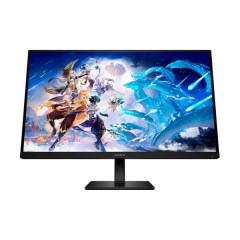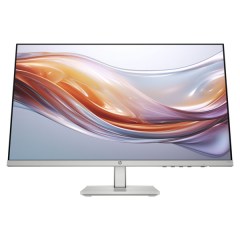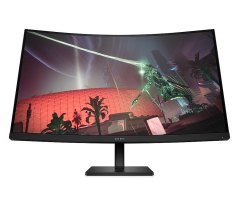BestReviews is reader-supported and may earn an affiliate commission. Details

A fast and powerful gaming monitor for serious gamers seeking a competitive edge as well as those who enjoy streaming content.
A refresh rate of 240Hz and 1ms response time make this ideal for serious online gamers. No lag or blur. The colors are bright with stark contrast. The QHD resolution provides vivid visual fidelity. The slim bezels are attractive and the port selection is vast.
Lacks 4K resolution, so images aren’t as detailed for next-gen consoles.

If you’re looking to upgrade your workspace for less, consider the HP Series 5 monitor, which delivers vibrant visuals, an adjustable design and an HDMI port for easy connectivity.
Offers a comfortable viewing experience for a budget-friendly price. Made of eco-friendly materials. Equipped with both HDMI and VGA ports. The display is solid enough for browsing the internet and working from home.
The refresh rate isn't the best, so it isn't great for gaming.

An exceptional monitor that performs well for gaming, working, and everything in between thanks to its high refresh rate.
Curved for maximum immersion. The 31.5-inch display provides a large enough space for you to see everything going on without losing peripheral vision during games. The QHD display combined with the 165Hz refresh rate works great for getting the most out of high-fidelity games.
Not the best option if you are looking to game in 4K.

We recommend these products based on an intensive research process that's designed to cut through the noise and find the top products in this space. Guided by experts, we spend hours looking into the factors that matter, to bring you these selections.

With so many high-end tech companies like Asus, Dell, and Samsung producing impressive computer monitors, HP remains a popular choice with PC owners due to their wide variety of displays, affordability, and overall dependability. Whether you are looking for a fairly inexpensive yet sharp-looking monitor for immersive PC gaming or an ergonomically designed model for the office, HP certainly has a monitor to accommodate your usage.
HP incorporates a range of screen sizes, resolutions, and features into their monitors, but with so many kinds of monitors in the HP lineup, it may be difficult for buyers to identify the best monitor for their needs at a glance. For instance, it would be a shame if you wanted a computer monitor for watching movies with others in the room without shopping around for HP monitors with wide viewing angles so everyone can clearly see the screen.
Whether you need a new HP monitor for gaming, creating digital art, or basic web browsing, there are some core concepts that anyone should keep in mind when buying a computer monitor.

A larger monitor will provide a more immersive viewing experience and is likely to include more useful and visually impressive features and technologies than smaller but more affordable models. HP’s displays range from 22-inch monitors and smaller to 27-inch monitors and larger. Although a computer monitor’s size alone is not the most important factor you should consider, users who plan on buying a monitor for viewing streaming apps of PC games from across the room may want to invest in a bigger model.
A computer monitor’s resolution is measured by the number of light-emitting pixels that form its display, and monitors that incorporate more pixels are brighter and more colorful, featuring a deeper contrast between bright and dark tones. You may be surprised to see the wide array of resolutions offered by HP’s monitors, ranging from HD+/900p, Full HD/1080p, QHD/1440p, and a few particularly impressive 4K UHD models.
Generally speaking, a computer monitor with a higher resolution is likely pricier than a model with a lower resolution. While a 4K UHD display may be worth it for playing PC games or enjoying video streaming apps, if you are going to use your new HP monitor for web browsing or online classwork, it may be worth saving some serious money by buying something with a lower resolution.
If you are buying a HP monitor for your office, it is a good idea to ensure that it incorporates a versatile collection of ports into its design. You probably do not want to have to purchase an additional connector to plug in an important device to your display down the road, so be sure to compare the essential ports included with the computer monitors you are considering. This includes DisplayPort, VGA, USB-C, and HDMI ports. USB ports are especially useful and commonplace ports, so the more USB-C ports built into a monitor, the better.
If you are considering a HP monitor with a higher resolution than your old monitor, double-check that your PC’s graphics card is capable of handling it before you buy.
High dynamic range, or HDR, is a technology that allows a computer monitor to display a much wider color gamut and a starker contrast between bright and dark tones. A computer monitor that supports HDR is worth buying for movie enthusiasts who want to see every detail and digital artists who need to create with a lifelike range of color.
While few HP monitors feature an integrated webcam, the ones that do are especially convenient for telecommuters and online students. Most HP monitors with a built-in webcam sport a sharp 1080p resolution and a design that retracts into the monitor for additional privacy.
Serious PC game players and video streamers will appreciate the immersive design of a curved display wrapping around their peripheral vision. Not only do wider curved monitors allow gamers to see more of their in-game world at once, these curved screens are naturally easier on the eyes, making them a top option as a workplace monitor.
The VESA mounting interface standard, often simply referred to as a VESA mount, is the universal standard for mounting a computer monitor to a wall or bracket. The good news is that the vast majority of HP monitors are designed for a VESA mount, so you can easily customize your new display as needed.
Many HP monitors, especially those optimized for productivity and gaming, incorporate a highly adjustable stand. If you are buying a computer monitor to stare at for hours on end, the ability to rotate, swivel, tilt, or adjust the height of a monitor can be a vital selling point.

Screen cleaner: Tech Armor Pro Cleaning Kit
A quality monitor cleaning kit is the best way to keep your display free of smudges, grime, and fingerprints. This comprehensive kid includes a gentle ammonia- and alcohol-free formula, plush microfiber cloths, and a few portable cleaning wipes.
Monitor stand: Mind Reader Mesh Monitor Stand
Not only does this elevated stand free up extra desktop space, its built-in shelves are a convenient place to set important notes, writing utensils, and other office essentials.
Inexpensive: Buyers with limited desk space or PC owners looking for an inexpensive HP monitor for viewing social media sites and writing emails will find plenty of solid models available for up to $250. A Full HD 1080p resolution, an ergonomic stand, and an UltraWide viewing angle are common features for computer monitors in this price range.
Mid-range: You may be pleasantly surprised to see the array of features and options offered in the $250 and $500 price range. Budget-conscious PC gamers and at-home workplace professionals will appreciate the QHD and 4K resolutions, game-enhancing technologies like AMD FreeSync and NVIDIA G-SYNC, and lifelike color gamut of these HP monitors.
Expensive: If you are considering taking home one of HP’s biggest, brightest, and best computer monitors, plan to spend $500 or more. These premium HP monitors are made for creative professionals and hardcore PC gamers who need a model with a lightning-fast refresh rate, a gorgeous 4K UHD resolution, or a curved display.
If you are interested in a dual-monitor setup for viewing a pair of PC screens from your desktop, HP features plenty of models with extremely slim bezels at a variety of price points.

A. Some of the ways PC users can avoid and greatly reduce eye strain include researching Eyesafe-certified HP monitors that minimize blue light without reducing its image quality, dimming your monitor’s LED backlight, and taking a break every 20 minutes or so to give your eyes a break.
A. Simply put, a computer monitor’s aspect ratio is the proportion between the width and height of the display. For example, most UltraWide monitors have a 21:9 aspect ratio that allows video game players to see more of their game’s world at once, but most modern computer monitors sport a 16:9 aspect ratio.
A. IPS monitors, also known as In-Plane Switching monitors, utilize parallel sequences of liquid crystals to create vibrant and high-contrast images. IPS monitors are best known for their lifelike range of color and wide viewing angles.
Get emails you’ll love.
Learn about the products you’re wondering if you should buy and get advice on using your latest purchases.
